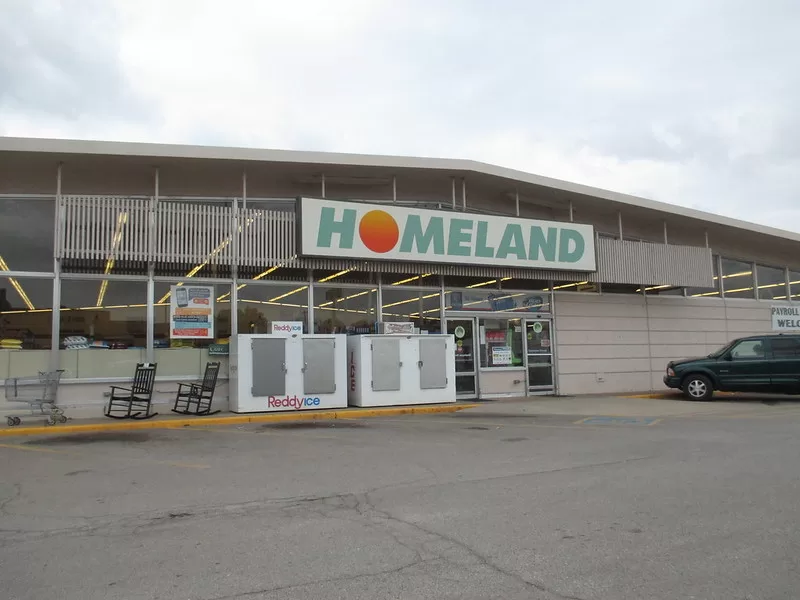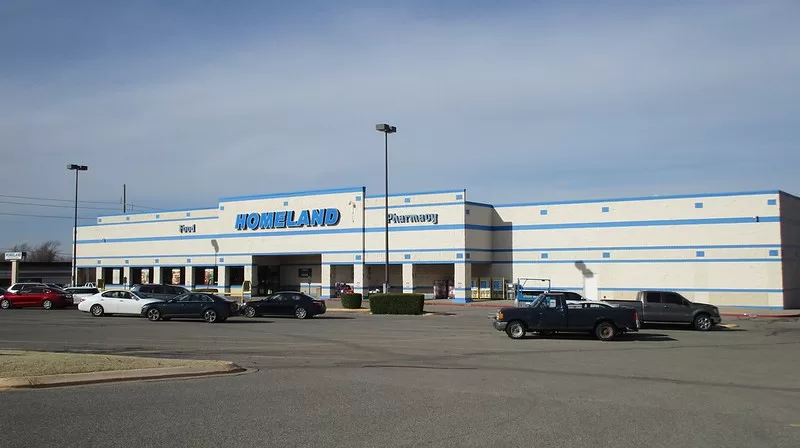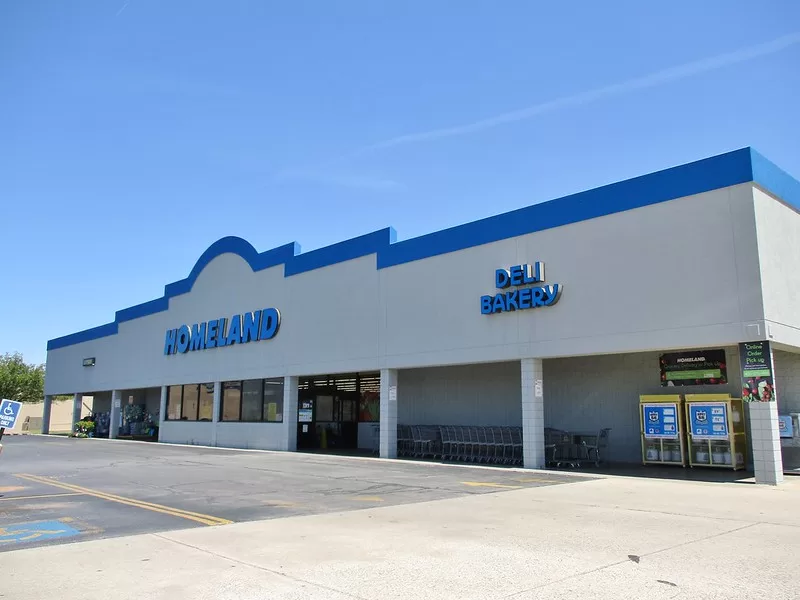Editor’s Note: This post was inspired by a request for information on the history of AppleTree’s “cousin” from Oklahoma, Homeland. The requester, Sing Oil Blog, has provided a companion post reporting on a Homeland-owned store in Georgia.
Howdy, folks, and welcome back to HHR. Today we’re looking at the history of a much more successful cousin of AppleTree, Homeland. Their history begins way back in 1929 when Safeway entered Oklahoma by acquiring a Tulsa-based chain, Sun Grocery. In 1936 Safeway would become the dominant chain in Oklahoma with their purchase of Kroger’s operations within the state. Throughout the 50s and 60s, Safeway would rapidly grow across Oklahoma, facing little competition from other major chains. Some competitors within the state included Skaggs-Alpha Beta/Albertsons, United Cash Stores, and various local chains. Growth was primarily limited due to Oklahoma’s shaky economy at the time. While Oklahoma was settled as an agricultural state, the Dust Bowl and the Great Depression pushed almost all of the state’s economy toward oil. The promise of oil and riches brought many people from diverse backgrounds to make their fortune in Oklahoma. As the blessings of an oil-rich economy continued, Safeway also kept growing. While the Oklahoma division was experiencing success, it would not be as resilient when the oil economy took turns for the worse. During the 1970s and 80s, Oklahoma went through boom and bust cycles. While we felt it here in Texas too, Oklahoma was particularly hard hit. As well in the years prior, Safeway’s Oklahoma division had experienced strikes at multiple levels. All these issues, combined with the rapidly aging store base, led Safeway to reexamine its operations there. While Oklahoma was an ailing division, it had promise, and Safeway would invest in it, building newer locations during booms. Unfortunately, in 1986, Safeway was targeted by Dart Group in a hostile takeover attempt. The chain could not prevent this buyout and was forced to accept a white knight bid. This new ownership meant that Safeway needed to pay down debt quickly. The best approach to this was by selling off their weakest divisions.

The Oklahoma Division of Safeway consisted of stores in Oklahoma, the Texas Panhandle, and Southern Kansas. Overall Safeway’s Oklahoma market share was good, and while the stores were a bit old, their reinvestment seemed to be paying off. Realistically though, with the strikes and the worst reported economic future for Oklahoma in that decade, the stores were close to being dumped. Safeway would first ask for wage concessions from the union. Before a response could even be made, Safeway announced their plans to close their Tulsa distribution center and six stores in the Oklahoma Division. As the distribution center supplied all the Oklahoma Division stores, plus Arkansas locations, it would need to be replaced, and Safeway proposed leasing the former Humpty Dumpty Warehouse in Oklahoma City for this. It seems around this time, the division’s management began to consider the idea of a buyout seriously. Downsizing to an even more outdated facility would hinder the division’s chances of survival. In 1987 the managers partnered with private equity firm Clayton, Dubilier & Rice to loan them money in exchange for majority ownership in the new company. Over the next year, the new company would license the Safeway name as they transitioned to Homeland, a name chosen by polling their employees. It’s not completely clear where the idea to spin off the company was born. However, the process was copied multiple times, creating Food Barn from the rest of Kansas, Harvest Foods from Little Rock, and AppleTree from the Houston division. AppleTree would quickly run into liquidity issues trying to pay down debt, going bankrupt before being forced to sell their stores by 1994. Kansas’ Food Barn would succumb to a similar fate. They also would go after Safeway, who they alleged overcharged and lied about the stores. Harvest Foods, on the other hand, immediately began investing in expansion. They purchased multiple other stores to integrate into the new chain and attempted to purchase a wholesaler to reduce costs. However, this approach would prove too much, and Harvest Foods filed for bankruptcy in 1995 and ceased operations in 1997.

Despite the poor outcomes of the other chains, Homeland existed in a somewhat of a sweet spot. They had spun off 106 stores, including the original Safeway distribution center and operations facilities, but not all the additional production facilities that weighed AppleTree down. Early on, Homeland nearly merged with Arkansas-based cousin Harvest Foods, likely based on the fact they had previously been supplied by the Oklahoma division of Safeway. This would have given the chain over 150 stores, stretching West from Texas to East Mississippi and North from Kansas into Northern Louisiana, including some former Weingarten’s locations! However, this merger would be canceled after a few months, with Homeland opting to first invest in updating its stores. A priority of these updates included bringing service departments to all stores and updating to more energy-efficient fixtures. Stores would also receive new signage made to fit inside former Safeway signs and a green coat of paint to cover up the old red. These remodels would be quite cost-effective and relatively easy to complete. However, the remodels did nothing to cover up the age of the stores, which was becoming more apparent. In the 1990s, following a tech boom in the Sooner State, new national competitors, like Albertsons and Food Lion, would flock to Oklahoma, looking to pick at Homeland’s weaknesses. While things were still more promising for Homeland than any of its cousins, by 1994, the chain was considering options to sell all or most of its operations. Homeland was running into the same problems AppleTree had been plagued by, labor issues in a sea of non-union grocers and increasing competition. Similarly to AppleTree, Homeland wouldn’t end up finding a buyer for the chain. They would instead enter into a structured bankruptcy with their creditors. In the bankruptcy, Homeland would lose its warehouse and about 30 of its locations to supplier AWG. These locations would be leased out to independent operators, and AWG would take over supplying the remaining Homeland stores.

With the sale of these stores and facilities, Homeland could pay off its debts and exit bankruptcy. While out of bankruptcy, the locations plucked by AWG were high-performing, and cash flow at Homeland was limited. Throughout the late 90s, while competitors continued to open new stores, Homeland only closed theirs losing around 30 locations overall. Similar to AppleTree, the company cut back to the bare essentials. Keeping on store staff with reduced wages but letting go of warehouse employees, drivers, and many other corporate-level positions. As Homeland was cutting back, some were losing faith in the brand. By 2001, Homeland would once again file for bankruptcy. During this filing, the chain seemed to be headed for doom. Homeland’s dwindling size, mixed with Wal-Mart dominating market share in these areas, meant many customers were forced out of shopping at Homeland. While things looked glum, careful management helped to save the now 14-year-old chain. The chain and its remaining stores were acquired by Associated Wholesale Grocers during the bankruptcy. The purchase by AWG was not entirely out of the blue. They had developed a relationship as a supplier for Homeland. AWG had also picked up most of the Safeway locations in Kansas City spun off as Food Barn years prior. AWG knew the Homeland brand had potential but required great care.

Homeland would be placed under AWG but allowed to continue operating as a supermarket chain. AWG would initially put its focus on trying to update the Homeland brand. This is when many of the original Safeway locations would close, including the Texas Panhandle Homelands and the few remaining Southern Kansas stores. Although, new Homeland locations began to pop up for the first time in years. AWG would help find suitable locations for new stores. Sometimes taking over from independents when they closed and occasionally being put into another national chain spot, namely Food Lion in the 90s and Albertsons by the 2000s. While Homeland still had tough competition in the form of Walmart, and starting in 2005, Aldi, Homeland was beginning to reestablish itself. Much like HEB has been able to sell itself on Texas Pride, Homeland has been able to sell itself on Oklahoma Pride. In 2008 Homeland would purchase the remaining Oklahoma locations of United Supermarkets from AWG. This move would be one of the first many propping Homeland up. Another would be the 2011 purchase of four stores in Texas to attempt and bring the brand back to the Lone Star State. All this would eventually lead to the spinning off of Homeland as an employee-owned company.
Photo: Charles Hathaway via Flickr (Albertsons) (Food Lion)
Throughout the 2010s, Homeland continued to grow, building their store base through newly built locations. As of 2023, Homeland has over 80 locations. Mainly concentrated in Oklahoma and one in Justin, Texas (just outside the greater DFW area). Homeland also operates continues to operate United locations in Oklahoma and converted their remaining Kansas store to Cash Saver. Homeland also operates locations across Georgia using the brands Food World and Piggly Wiggly. Overall, things are looking up for Homeland at the moment. They’re finally at a point again when they can build new stores, some of which don’t look half bad! It’s been a crazy journey, but it looks like the only survivor of the Safeway spin-off may outlive Safeway itself!



Having visited several Homeland stores during business trips to Oklahoma, I have to say I find them to be very pleasant places to shop, though not spectacular. It reminds me quite a bit of shopping at a Gerland’s back in the day. That’s actually quite a refreshing thing to experience, as such stores have largely disappeared from the Houston market.
I never knew Homeland had such a storied past, especially with ties back to Safeway! With all the troubles Homeland had in its early years, it’s quite impressive they’ve gotten themselves to the point where they are now, going from a chain on the brink of death to one that’s expanding again. That story reminds me of Winn-Dixie right now, who is building new stores again for the first time in almost two decades, and trying to clean up stores and complete a massive turnaround. It seems rare for a grocery chain to make such a successful turn, but I’m glad Homeland was able to become one of the exceptions to the rule!
It is quite surprising that the national chains are absent in Oklahoma right now. It’s not that they have not tried Oklahoma, but things just have not worked out. Albertsons is rumored to be interested in opening a new location in a part of Oklahoma not far from the Dallas market. I think Albertsons could have success in Oklahoma. Heck, Kroger should be able to be successful, but for whatever reason, these chains have not been eager to take on Homeland (and Walmart, of course) in modern times. Oh well, at least Homeland keeps the memory of national chains past alive!
While Homeland has a similar history, at least initially, as AppleTree, I would say that Homeland’s stores are somewhat of cousin stores to our Food Town stores in Houston at least in the sense that both have their share of only lightly touched, or re-touched, Albertsons, Safeway, and Food Lion stores! As we see with Sing Oil’s post, things go even deeper than that in ways that even Food Town can’t match. Of course, while Food Town can be described as a small player in Houston, Homeland is pretty much the dominant grocer in major parts of Oklahoma aside from Wal-Mart.
Anyway, it is neat to see the history of Homeland written out like this and I’m glad to see a collaboration between HHR and the Sing Oil Blog!
I know I was certainly shocked by by how deep the history East Dublin Food World goes–thanks again for the tip!
And thanks again to Mike for writing up all of this history on Homeland because I never would have known all of the twists and turns of the company. I still wonder why they decided to expand into Georgia, but I guess that makes more sense than Kmart in Guam or Winn-Dixie in the Bahamas!
Believe it or not, Winn-Dixie once had stores in Oklahoma. The Beef People tried to dump them, and the Dallas-Ft. Worth Winn-Dixies, to Kroger, but the FTC nixed the proposal. There are probably some Winn-Homelands out there and I wouldn’t be shocked if a Golden Girls Homeland exists!